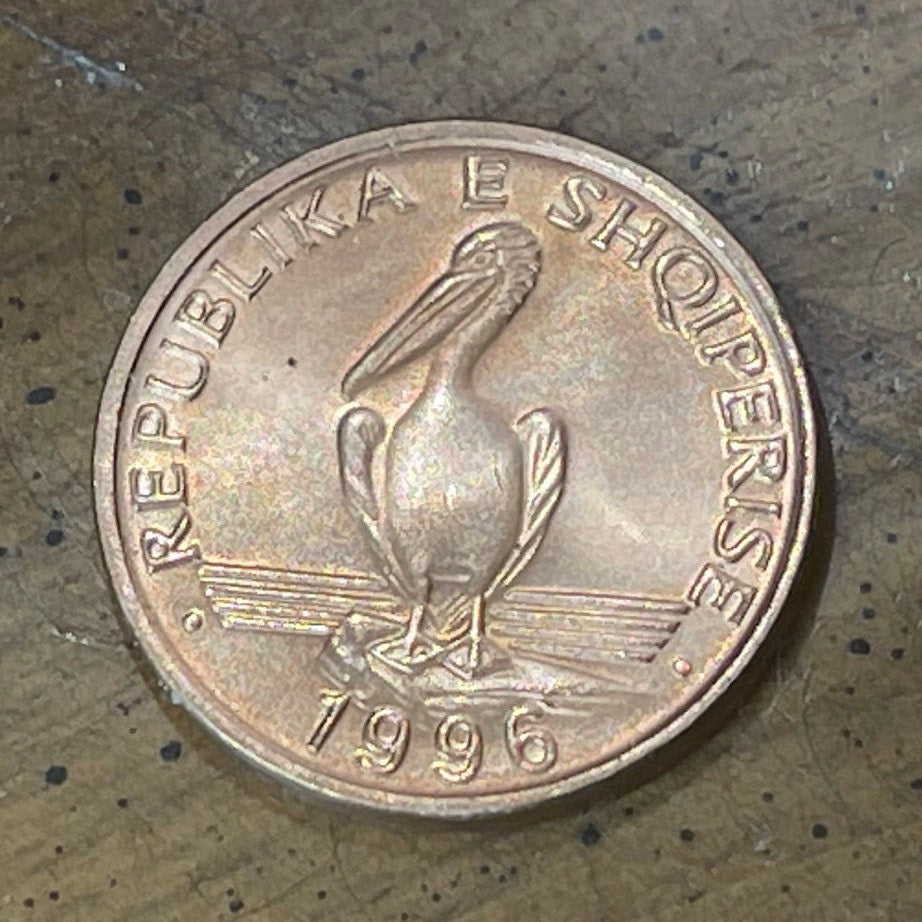elemintalshop
Dalmatian Pelican 1 Lek Albania Authentic Coin Money for Jewelry and Craft Making
Dalmatian Pelican 1 Lek Albania Authentic Coin Money for Jewelry and Craft Making
Couldn't load pickup availability
Dalmatian Pelican 1 Lek Albania Authentic Coin Money for Jewelry and Craft Making
Obverse: Dalmatian Pelican left
Lettering: · REPUBLIKA E SHQIPERISE ·
1996
Translation: Republic of Albania
Reverse: Denomination
Lettering:
1
LEK
Features
Issuer Albania
Period Fourth Republic (1990-date)
Type Standard circulation coin
Year 1996
Value 1 Lek
1 ALL = 0.0096 USD
Currency New lek (1965-date)
Composition Bronze
Weight 3 g
Diameter 18.1 mm
Thickness 1.64 mm
Shape Round
Orientation Medal alignment ↑↑
Number N# 6530
References KM# 75
Wikipedia:
The Dalmatian pelican (Pelecanus crispus) is the largest member of the pelican family, and perhaps the world's largest freshwater bird, although rivaled in weight and length by the largest swans. They are elegant soaring birds, with wingspans that rival that of the great albatrosses, and their flocks fly in graceful synchrony. With a range spanning across much of Central Eurasia, from the Mediterranean in the West to the Taiwan Strait in the East, and from the Persian Gulf in the South to Siberia in the North, it is a short-to-medium-distance migrant between breeding and overwintering areas. No subspecies are known to exist over its wide range, but based on size differences, a Pleistocene paleosubspecies, P. c. palaeocrispus, has been described from fossils recovered at Binagady, Azerbaijan.
This species of pelican has declined greatly throughout its range, more so than the white pelican. It is possible that up to 10,000–20,000 pelicans exist at the species level. During the 20th century, the species' numbers underwent a dramatic decline for reasons that are not entirely understood. The most likely reason was habitat loss due to human activities such as the drainage of wetlands and land development. Colonies are regularly disturbed by human activity, and, like all pelicans, the parents may temporarily leave their nest if threatened, which then exposes the chicks to the risk of predation. Occasionally, Dalmatian pelicans may be shot by fishermen who believe the birds are dangerously depleting the fish population and hence threatening their livelihood. While such killings are generally on a small scale, the worry that these pelicans over-exploit the fishing stock persists in many locales. Another probable reason for the decline in the species' population is poaching. In Mongolia, the local people clandestinely kill these pelicans to use or sell their bills as pouches. On a typical day in a commercial Mongolian marketplace, as many as fifty pelican bills may be on offer for sale, and they are considered such a rare prize that ten horses and thirty sheep are considered a fair price to trade for a single pelican. Due to exploitation at all stages of the life cycle, the species is critically endangered in its Mongolian range, with a total population of fewer than 130 individual birds. Dalmatian pelicans also regularly fly into power-lines and are killed by electrocution. In Greece, pelicans are often so disturbed by power boats, usually ones bearing tourists—that they become unable to feed and die of malnourishment. In 1994 in Europe there were over a thousand breeding pairs, most of them in Greece, but also in Ukraine, Macedonia, Romania, Bulgaria (Srebarna Nature Reserve) and Albania (Karavasta Lagoon). They have been considered extinct in Croatia since the 1950s, although a single Dalmatian pelican was observed there in 2011. The largest single remaining colony is at Small Prespa Lake (shared between Albania and Greece), with around 1,400 pairs, with approximately 450 pairs left in the Danube Delta. The country with the largest breeding population today, including about 70% of pairs or possibly over 3,000 pairs, is Russia. Worldwide, there are an estimated 3,000–5,000 breeding pairs. One report of approximately 8,000 Dalmatian pelicans in India turned out to be a congregation of misidentified great white pelicans.
The Dalmatian pelican is one of the species to which the Agreement on the Conservation of African-Eurasian Migratory Waterbirds (AEWA) applies. Conservation efforts have been undertaken on behalf of the species, especially in Europe. Although they normally nest on the ground, Dalmatian pelicans have nested on platforms put out in Turkey, Greece, Bulgaria and Romania in order to encourage them to breed. Rafts over water have also been set up for the species to use in Greece and Bulgaria. Power-lines have also been marked or dismantled in areas adjacent to colonies in these countries. Additionally, water-level management and educational programs may be aiding them at a local level. Although efforts have been undertaken in Asia, there is a much higher rate of poaching, shooting and habitat destruction there, which may make conservation efforts more difficult. In 2012, when unusually frigid winter conditions caused the Caspian Sea to freeze over, it resulted in the death from starvation of at least twenty of the Dalmatian pelicans that overwinter there. Despite local authorities' initial attempts to discourage it, many people there turned out with fish and hand-fed the birds, apparently enabling the huge pelicans to survive the winter.
Share










4 stars review from Kiki
5 stars review from Crystal
Very nice, exactly as described, packed well for quick shipping.
It is a very nice coin - very pleased
I'm a casual/novice coin collector. I ordered 21 coins from Elemintal, based on places I've traveled and themes I thought were interesting. They arrived quickly and safely. Each coin was in an individual plastic sleeve, and they were protected by cardstock in a padded envelope. This coin was in very nice condition. No scuffs or scratches and no tarnish. It looks almost brand new even though the stamped date is 1996. Thank you!









